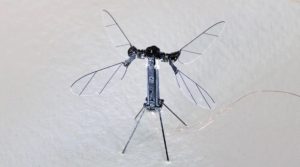Kenneth Lamm
Professor Arielle Saiber
World Science Fiction
3 April 2020
The Red Orchestra
“General Ilyich, the beetles successfully bred.”
The officer peered in the plastic cage. Two red beetles– no larger than sesame seeds– scurried about their young.
“We perfected their mating call, doctor. They are engineered at one decibel.”
“Excellent. Send them out.”
A farmer stood under a blazing Arkansas sun, blinded by the glare bouncing from the millions of spinach leaves sprawled about him. He stepped through the rows and turned the leaves over. Green and luscious, he thought to himself. It was going to be another healthy harvest this year. As he walked towards his tractor on the other side of the field, he bent over and flipped over another leaf. Three red beetles, barely visible to his weather-beaten eyes, fell off the leaf and burrowed themselves in the soil.
“I swear Professor Smith! They were red!”
“Don, there are only two Sonoptera presidentatus morphs: white and blue. I have spent 25 years studying these Spinach beetles and have never come across any other colors. They are native to North America and no other similar species are found around the world.”
“But they stood out so clearly against the green leaves! You scientists; you never trust the true eyes of agriculture. Dammit, I’ll catch a handful and bring them to this lab.”
The farmer stormed out of the professor’s room and skidded out of the parking lot in his Chevrolet.
Three mornings later, the farmer jolted awake. Did I forget to turn off the radio? He stumbled out of bed and into his kitchen. His speakers were off. I must be dreaming. He tried to fall back asleep but the music rang in his ears louder and louder. After an hour he had had enough.
Outside only a thin red line of dawn was visible from the horizon, but music blared from the field.
“Who’s there!?”
No response came. He picked up the shotgun next to his door and crept towards his plants. He sat crouched for a while but saw nothing. As the morning came, the music slowly lessened in volume and stopped by the time the sun had risen. The farmer stood up and stepped into the field. Everything looked normal. He flipped over a leaf and a dozen red beetles scrambled about. He caught them in his hand and stuffed them in the pocket of his overalls.
Under the microscope everything aside from the color of the beetle- from the furry antennae to the stubby legs- looked identical to the Sonoptera presidentatus specimen Professor Smith had on his lab bench.
“I don’t know how this is possible…how could they be red?”
“These things were making a ruckus last night! Most bizarre of all, their calls sounded like some sort of tune.”
“S. presidentatus are only known to communicate through pheromones. What was the sound you described?”
“Almost like, you know, a national anthem?”
Professor Smith exploded in laughter. The farmer once again fumed out of the entomologist’s lab.
The next week, police arrived on Don’s farm after failing to deliver spinach to a client. They found the farmer’s stiff body in his bed. No blunt trauma, no poisoning, died of natural causes, the officers recorded. On the way out of the house, an officer noticed a crunch beneath his feet. He lifted up his shoe and found it a single red splotch.
A year later, a death of another Arkansas farmer was reported. Two years later, even more mysterious deaths of farmers arose. Every investigation led to no indication of malicious activity. Then, Arkansas’ lead entomologist Richard Smith was found dead in his lab, sitting in his chair clutching a microphone over a terrarium housing thousands of red beetles. Next to him was a notebook titled “The Auditory Mating Tactics of a New Morph of Sonoptera presidentatus”. The police took the microphone recordings with them for further analysis.
“General Ilyich, our mission is well underway. Several targets have already been eliminated after the beetles exploded in populations. Think about it! One beetle may produce a decibel, but a whole field full of them? Ha! The democratic scum will perish while listening to our country’s music!”
“Excellent. Can you modify these to survive on grass?”
“Absolutely.”
“Get to work. The White House lawn will never have sounded so beautiful…”








